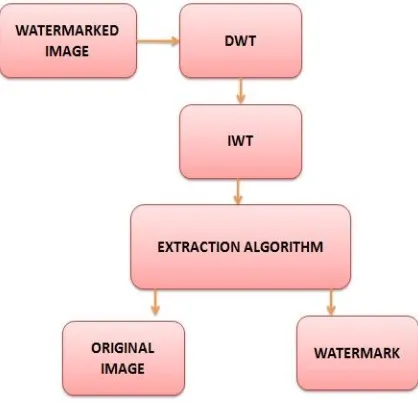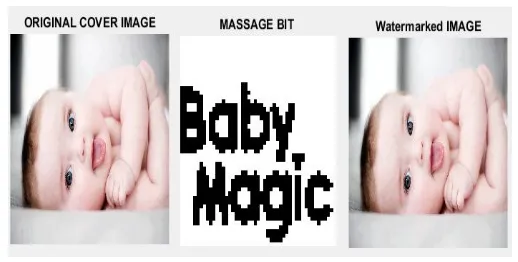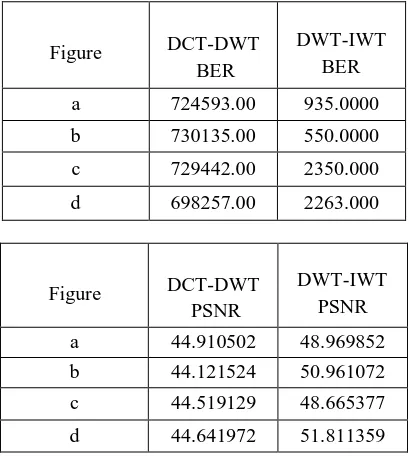A Novel Approach to Increase the Embedding Capacity
in Digital Watermarking Using DWI-IWT
Harshitha R1, Vidya S S2, Dr Suresh H N3
1M. Tech, Department of Electronics and Instrumentation, Bangalore Institute of Technology, V.V.Puram, Bangalore 560004,
Karnataka, INDIA.
2 Assistant Professor, Department of Electronics and Instrumentation, Bangalore Institute of Technology, V.V.Puram, Bangalore
560004, Karnataka, INDIA.
3 Professor & PG Coordinator, Department of Electronics and Instrumentation, Bangalore Institute of Technology, V.V.Puram,
Bangalore 560004, Karnataka, INDIA.
Abstract: watermarking is a development that supplements cryptography by embeddings impalpable flags in work. Information covering strategies have starting late ended up being imperative in different application zones. Propelled sound, video and pictures are dynamically furnished with perceiving however intangible engravings, which may contain a covered copyright see that expects unapproved copying particularly. One approach is to introduce an imperceptible picture known as digital watermarks into a photo progression. This paper presents secured counts for embeddings advanced watermarks into pictures. The proposed methodology performs undefined watermarking of pictures in repeat space. The watermark is embedded in the discrete wavelet (dwt) and integral wavelet (iwt) transform on a photo in a multi-dimensional way. In the interpreting stage, once the watermark is expelled from the watermarked picture, certain execution measures, as peak signal to noise ratio (psnr) and correlation are figured. Regardless of the way that iwt technique gives better results when appeared differently in relation to dwt, results by joining both iwt-dwt together are amazing.
Keywords: watermarking, iwt, dwt, ber, design of watermarking systems, embedding capacity, robust.
I. INTRODUCTION
The need to make duplicate, transmit and convey digital information as a part of widespread multimedia technology in internet era is common .. In this manner copyright security has ended up being essential to avoid unapproved duplicate issue. Digital watermarking gives copyright confirmation to picture by stowing away proper data in unique picture to announce legitimate proprietorship. Robustness, Perceptibility, embedding capacity and bit error rate are four essential factors to determine quality of watermarking scheme [10-11]. The Watermarking computations are completely sorted as Spatial Domain Watermarking and Transformed domain watermarking. In spatial domain, watermark is installed by specifically adjusting pixel estimations of cover image . Least Significant Bit inclusion is case of spatial domain watermarking.In Transform domain, watermark is embedded into changed coefficients of picture giving more data concealing limit and more power against watermarking assaults since data can be spread out to whole picture [9] .Keeping in mind the end goal to further execution enhancements in changed based computerized picture watermarking calculations are acquired by consolidating each changes [8] .Subsequently of blend of calculations Robust and secure watermarked picture are gotten [7] .In this paper we go for expanding the installing limit and vigor to get a vague watermarked picture. As a blend we utilize DWT-IWT . Utilization of IWT which includes the lifting method increments inserting limit of the watermarked picture [6 ]. The DWT is closer to human visual framework than DCT. Since both changes utilized are wavelet changes the scaleability and resistance to the implanting calculation connected is relied upon to be great .
II. COMBINED ALGORITHMS DWT-IWT
A. Discrete wavelet transform
dimensional picture after three-level DWT decomposition can be appeared as Fig.1. Where, H speaks to high-pass channel, L speaks to low-pass channel. A unique picture can be made of recurrence locales of HL1, LH1, and HH1. The low-frequency district data likewise can be disintegrated into sub-level recurrence area data of LL2, HL2, LH2 and HH2. By playing out this the first picture can be deteriorated for n level wavelet change. Ordinarily the greater part of the picture vitality is gathered at the lower level frequency sub-groups LLx and accordingly installing watermarks in these sub-groups may despite the fact that debase the picture it could build heartiness altogether
Fig:1 Sketch Map of Image DWT Decomposed
In another way, the high frequency sub-groups HHx incorporate the edges and surfaces of the picture and the human eye is not by and large touchy to changes in such cases sub-groups. This enables the watermark to be inserted without being seen by the human eye. The trade off embraced by numerous DWT-based watermarking calculation, is to install the watermark in the center recurrence upper-groups LHx and HLx where adequate execution of heartiness and impalpability can accomplished. [3-2].
B. Integer wavelet transform
III. THE COMBINED DWT –IWT ALGORITHM A. Watermark embedding algorithm
Fig:2 Watermark embedding
Firstly DWT technique is applied to decompose the cover host image into four non-overlapping multi-resolution sub-bands: LL1, HL1, LH1, and HH1.then we divide the any of the sub-band HL1 (or HH1) into 16 x 16 blocks. After dividing into blocks we apply IWT which includes lifting scheme of watermarking where each floating point coefficient is rounded to the integer value for , each block in the chosen sub-band. Now we Re-formulate the grey-scale watermark image into a vector of zeros and ones. Two uncorrelated pseudorandom sequences is generated . One sequence is used to embed the watermark bit 0 (PN_0) and the other sequence is used to embed the watermark bit 1 (PN_1). Embedding of the two pseudorandom sequences, PN_0 and PN_1, with a gain factor, in the Integer Wavelet transformed 16x16 blocks of the selected DWT sub-bands of the host image is further done . Embedding is not applied to all coefficients of the IWT block, but only to the selected coefficients. By applying inverse IWT to each block after its coefficients have been modified to embed the watermark bits as described in the previous step the inverse DWT is applied on the DWT transformed image, including the modified sub-band, to produce the watermarked original (host) image.
B, Watermark Extraction algorithm
using the extracted watermark bits, and compute the similarity between the original image and extracted watermarks.
Fig 3: Watermark extraction
IV. RESULTS AND DISCUSSION
The MATLAB (R2015a) is used to implement and to analyse the proposed algorithm . Due to its advances in image processing tool boxes and inbuilt functions the coding is done using Matlab . The parameters used are RGB original images of size 512X512 jpg and png formats the three RGB watermark images of size 64x64 bmp format. The original images taken are the colour babies images and the watermarks that is embedded are the logo of baby products . For the illustration few images and watermarks are shown in the figure 4. The experimental analysis was conducted by using various original images and watermarks and the performance parameter PSNR values of the proposed algorithm are calculated and tabulated only for few images. The PSNR (peak signal to noise ratio) value is an image quality measurement index. The PSNR and MSE between the watermarked image and original image is calculated using Eq.(1) and (2)
..(1)
..(2) Ii,j = original-image
Fig 4: original images and watermarks
Different attacks such as noise attack ,blurring ,rotation are applied on the watermarked image to check for the robustness. When we compared this with all other methods the combination algorithm of DWT-IWT works very well .
A. Results for host image quality
(b)
(c)
(d)
(e)
(f)
(h)
Fig 5: (a)(c)(e)(g) Watermarked images (b)(d)(f)(h) Histogram Comparison
Table 1: MSE Comparison with other Algorithm for different Images
Table 2: BER Comparison with other Algorithm for different images.
Table 3: PSNR Comparison with other Algorithm for different images .
V. CONCLUSIONS
[image:8.612.203.408.382.614.2] [image:8.612.204.409.385.613.2]By combing the two common frequency domain methods, we could take the advantageous of both two algorithms to improve the performance in IWT-based digital image watermarking using lifting scheme .Two transforms are combined to get a high embedding capacity in watermarking with reduced Bit Error Rate , Since both transforms used are wavelet transforms the
Figure DCT-DWT
MSE
DWT-IWT MSE
a 2.082655 0.824319
b 2.497555 0.521162
c 2.261144 0.849850
d 2.215492 0.428494
Figure DCT-DWT
BER
DWT-IWT BER
a 724593.00 935.0000
b 730135.00 550.0000
c 729442.00 2350.000
d 698257.00 2263.000
Figure DCT-DWT
PSNR
DWT-IWT PSNR
a 44.910502 48.969852
b 44.121524 50.961072
c 44.519129 48.665377
saleability and tolerance to the embedding algorithm applied is good and also we get the robust watermarked image with high quality which is more robust then the Spatial technique. There is a scope of future work in developed technique, this technique is still applicable for images only but it technique can also developed for audio, videos because we know that audio is also represented in frequency component and video is a collection of image frame so watermarking can be inserted in that both and make audio and video watermarking effectively.
VI. ACKNOWLEDGMENT
Any achievement, be it scholastic or otherwise does not depend solely on the individual efforts but on the guidance, encouragement and co-operation of intellectuals, elders and friends. A number of personalities, in their own capacities have helped me to work on watermarking . I would like to take this opportunity to thank them all. I would like to thank my PARENTS for their constant moral support throughout. I also extend my sense of gratitude and sincere thanks to all the faculty members of Electronics and Instrumentation Engineering, Bangalore Institute of Technology, for their constant encouragement and support.
REFERENCES
[1] Lin, S. and C. Chin, "A Robust DCT-Based Watermarking For Copyright Protect”, IEEE Trans. Consumer Electronics, 46: 415-421, 2000.
[2] Ejima, M. and A. Myazaki,."on The Evaluation Performance Of Digital Watermarking in The Frequency Domain (FD)”, in Proceeding of the IEEE Int. Conference. on Image Processing, 2: 546-549, 2001.
[3] R. Mehul and R. Priti, “Discrete Wavelet Transform Base Multiple Watermarking”, Proceedings of IEEE Region 10 Technical Conference on Convergent Technologies for the Bangalore, Asia-Pacific,, India, October 14-17- 2003.
[4] Sambaran Bandyopadhyay , Ruchira Naskar and Rajat Subhra Chakraborty , ‘Reversible Digital Watermarking using Integer Wavelet Transform’, International Conference on ReConFigurable Computing 2015 .
[5] L. Agrwal, A. Yadav, U. Kumar and S. K. Gupta ‘Improved invisible watermarking technique using IWT-DCT’, 2016 5th International Conference on Reliability, Infocom Technologies and Optimization (Trends and Future Directions) (ICRITO), Noida, 2016, pp. 283-285.
[6] Ravi K Sheth , Dr. V V Nath. ‘Secured Digital Image Watermarking with Discrete Cosine Transform and Discrete Wavelet Transform method ‘, International Conference on Image Processing (ICIP) .978-1-5090-0673-1/16 IEEE - 2016.
[7] Malika Narang, Gurgaon Sharda Vashisth ‘Digital Watermarking using Discrete Wavelet Transform’, International Journal of Computer Applications 2013. [8] K.Thaiyalnayaki,, A .Kala” Dual Robust Watermarking Using Integer Wavelet Transform And Singular Value Decomposition” International Journal of Remote
Sensing & Geoscience (IJRSG ) ISSN No: 2319-3484 Volume 2, Issue 6, Nov. 2013 .
[9] Digvijaysinh Vaghela , Ram Kishan Bairwa ‘’Digital Image Watermarking Using DWT Based DCT Technique ‘ International Journal of Recent Research and Review, Vol. VII, Issue 4, December 2014
[10] GhoutiL, BouridaneA and Ibrahim MK, “Digital image watermarking using balanced multi wavelets” , IEEE Transactions on Signal Processing, 54(4), pp. 1519-1536, 2006.


